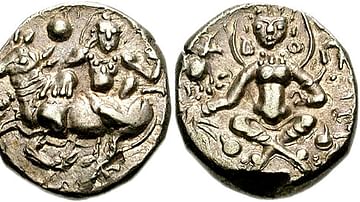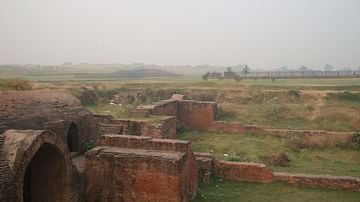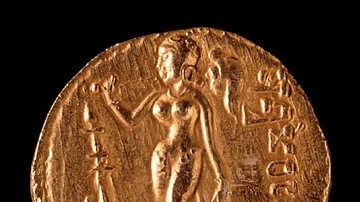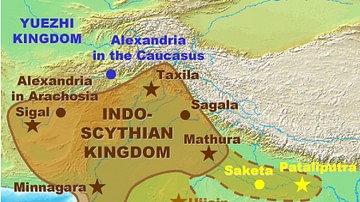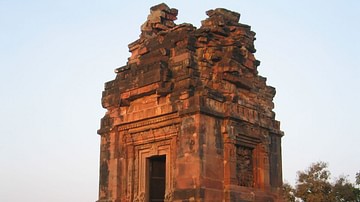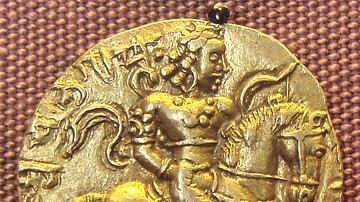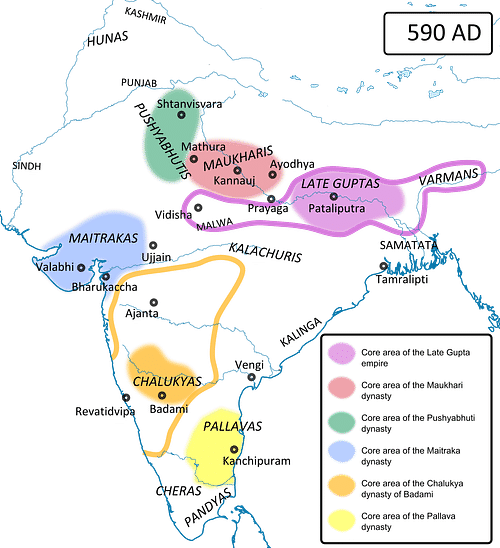
The Maukharis (554 CE - 606 CE) rose as a power after the downfall of the Gupta Empire (3rd to 6th century CE) in the 6th century CE in northern India. The core area of their kingdom was situated in what is now the state of Uttar Pradesh in India with the capital at Kanyakubja (modern-day Kannauj city). Although the Maukharis had long-existed as a feudatory dynasty, for nearly half a century beginning 554 CE, they established a powerful kingdom vying with other regional powers for political supremacy in India. The rise of the Kanyakubja kingdom was short-lived and it came to be known ultimately as the base kingdom for which future empires hotly contested.
Political Conditions in 6th Century CE India
The fall of the Gupta Empire, and the absence of any other empire in its stead, led to the political disintegration of northern India. Now, there arose a number of independent powers:
- The Pushyabhutis (also called the Vardhana dynasty by some historians) of Sthanvishvara (Thanesvara or Thanesar, in present-day Haryana state)
- The Maukharis of Kosala/Kanyakubja
- The Later Guptas of Magadha and Malwa (present-day states of Bihar and Madhya Pradesh).
The other kingdoms included those established in the present-day states of Odisha, Bengal and Assam. Among these, “the Maukharis and the Later Guptas were the most powerful and were destined to play an important part in the later history of India” (Majumdar, 40).
In the 7th century CE, the Gauda kingdom under King Shashanka (c. late 6th century CE - 637 CE) came into being, comprised of the northern and most of the western parts of Bengal.
Origins of the Dynasty
The origins of the Maukharis as a family were rooted in antiquity but their existence as a political power of note occurred only in the 6th century CE. A number of Maukhari inscriptions indicate that the family had many branches ruling either as chiefs or feudatories of the Guptas from many parts in northern India, with the most important being that of Kanyakubja. A clay seal bearing the legend “Mokhalinam” (Pali: “of the Mokhalis/Maukhalis/Maukharis”) in the Brahmi script in use during the Mauryan emperor Ashoka's (272 - 232 BCE) time shows that the Maukhari family existed in the Mauryan period (4th century BCE - 2nd century BCE).
Much of the information regarding the Maukharis comes from their inscriptions of which many have been found, their coins, from the Harshacharita or the biography of the Pushyabhuti emperor Harshavardhana or Harsha (606 – 647 CE) written by his court poet Banabhatta or Bana (c. 7th century CE) and from the Aryamanjushrimulakalpa, a Buddhist text written sometime after the 6th century CE. The Maukharis are referred to as the house of Mukhara in the Harshacharita.
The first three rulers of the Kanyakubja branch were Harivarman, Adityavarman and Ishvaravarman, repectively. They came to accept the might of the Later Guptas and concluded matrimonial relations with them. Their status remained as that of normal kings and they are not credited with any conquest or any other action of note.
Rise of the Dynasty: King Ishanavarman
The arrangement with the Later Guptas however changed with time as under King Ishanavarman (c. 6th century CE), the son and successor of Ishvaravarman, the Maukharis began to assert their power and establish their own independence. Ishananavarman ascended the throne in 554 CE and unlike his predecessors, was quick to realize the nature of the prevailing political conditions in the country and the opportunity it afforded to an ambitious ruler, for “the gradual weakening of the Gupta power made their feudatories in the different parts of the country cherish a feeling of rivalry and hostility among themselves, through their desire for political supremacy” (Basak, 120-21).
Ishanavarman decided to open hostilities with the Later Guptas in order to conquer Magadha (modern-day Bihar). Owing to the existence of multiple kingdoms none of which were superior to each other, it was possible at any point of time for alliances to break and rivalries to be formed. The conquest for power meant that sooner or later each kingdom would wage war on its neighbour to conquer more territory and prove itself as more powerful. The absence of a powerful overarching empire to keep order and to cow lesser kingdoms into submission made it possible for these kingdoms to wage war on each other as and when it suited them.
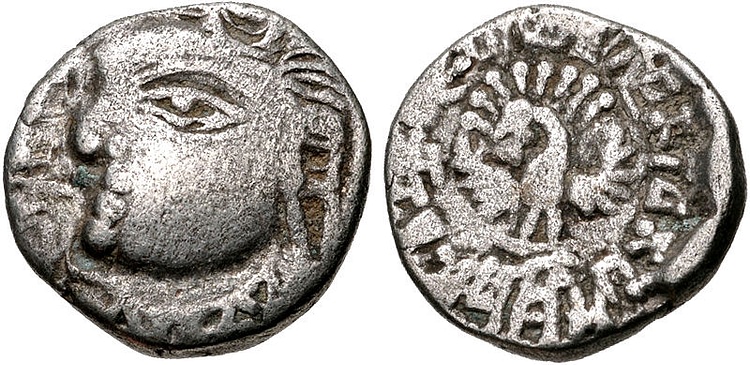
Carrying out extensive military campaigns, “Ishanavarman was the first to bring the family into eminence” (Tripathi, 289). According to his inscriptions, he defeated the Andhras of south-eastern India, Sulikas (not as yet identified) and the Gaudas. This increased the political power of the Maukharis and alarmed the Later Gupta king Kumaragupta III who defeated Ishanavarman but could not completely crush him.
Later Kings
Ishanavarman was succeeded by his son Sarvavarman (c. 6th century CE). He challenged the Later Guptas in order to avenge the defeat of his father. Kumaragupta's son and successor Damodaragupta (c. 6th century CE) continued the fight with the Maukharis but fell in battle, possibly against Sarvavarman, who then occupied Magadha or a large portion of it. Damodaragupta's son Mahasenagupta (c. 6th century CE) retired to Malwa after suffering a further blow to his power as he lost Gauda to his feudatory Shashanka who became its first independent king.
Sarvavarman during his reign added further to the power of his family. According to an inscription, he defeated the Hunas (Huns) of north-western India. The details of these wars, however, have not as yet been discovered. The Harshacharita does mention that the Pushyabhuti kings fought against the Hunas but since they were not militarily strong enough to take them on by themselves, “and, as Thanesvara lay between Kanauj and the Huna territories in the south-east of the Punjab, it may not be unreasonable to suppose that Sarvavarman's undertakings against the Hunas were a sort of help” (Tripathi, 47) given to the Pushyabhutis in this war.
Not much is known about his successor Avantivarman (c. 6th century CE). He was succeeded by his son Grahavarman (c. 6th century CE – early 7th century CE), the last king of the dynasty, who was killed by the Later Guptas. By Grahavarman's time, the Maukharis had become a power to reckon with. Bana in his Harshacharita writes that “Now at the head of all royal houses stand the Mukharas, worshipped, like Shiva's foot-print, by all the world” (Banabhatta, 122). Thus, “Banabhatta's eulogy undoubtedly conveys the idea that the Maukhari rulers enjoyed great power and distinction up to the beginning of the seventh century AD” (Majumdar, 69).
Extent of the Kingdom
The Maukhari kingdom consisted of most of present-day Uttar Pradesh state and parts of Bihar. Numerous coins of Ishanavarman, Sarvavarman and Avantivarman that have been found attest to the political supremacy enjoyed by the Maukharis in north-eastern India. Ishanavarman's wars against the Sulikas and Andhras did not result in any territorial annexations, thus implying that they were in all probability defensive wars.
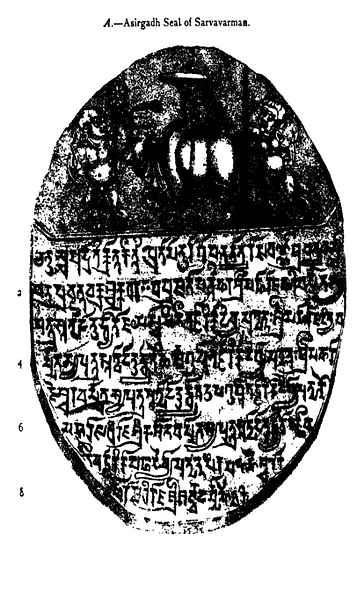
Religion & Administrative Conditions
The Maukharis belonged to the Kshatriya (ruler-warrior) caste as their suffix “varman” shows. They were staunch Hindus, favoured orthodoxy and tried to enforce and maintain the traditional social order among the people. Hinduism received state support, but Buddhism also managed to remain as a prominent religion.
The city of Kanyakubja grew in prosperity and importance and as a great cosmopolitan town. “All the special economic, social, political and religious features that marked the Gupta period were preserved, with slight modifications, here and there” (Basak, 315). The Maukhari kings were patrons of poets and writers and many literary works were composed during their reign.
The first three Maukhari kings are mentioned in the inscriptions as maharaja or “great king”, but their successors assumed grander titles showing the subsequent increase in power. Thus, unlike his predecessors, Ishanavarman was the first Maukhari to adopt the title Maharajadhiraja (“Sanskrit: Lord of Great Kings”) owing to his military victories and the increase in power. He thereby also gained the right to issue coins. These coins resemble some of the coins of the Gupta emperors.
Army
The army in this period consisted of elephants, cavalry and infantry. Ishanavarman in all probability would have taken much pains to reorganize the army and make it combat-worthy. His successful campaigns against a myriad of foes known for their powerful corps - the Andhras for their elephants and the Sulikas for their cavalry - attest to this fact.
The Maukhari strategy centred on deploying the elephant corps to crush the enemy masses and they were used against both the Hunas and the Later Gupta armies, although the results were not always favourable, as Damodaragupta, for instance, was able to destroy their battle array. It is also quite possible that the Maukharis, as feudatories of the Gupta emperors, had fought alongside them in their wars with the Hunas and hence were aware of the Huna tactics and style of warfare, something that aided them in their wars as independent kings later.
The mention in the Maukhari inscription that the Gaudas were defeated and driven further towards the sea coast to take shelter in the sea, implies that being a land-locked power, the Maukharis did not possess any navy. Thus the Gaudas could no longer be pursued or beaten once they had taken to the sea.
Many of the kings and princes were also adept in the art of warfare such as Ishanavarman and prince Anantavarman who was well known for his skill as an archer, particularly against enemy cavalry and elephants. Ishanavarman's inscriptions describe him as a valiant warrior whose hands were hardened and callused by the repeated use of the bow on the battlefield. His armies are stated to be vast and continuously on the march.
In the time of Grahavarman however, military capabilities seem to have declined as the Mukharis lost out quite easily to the invading forces of the Later Guptas, and neither were they aware of the impending attack. As historian RC Majumdar writes, “the Maukharis were evidently taken by surprise, for no inkling of this invasion had reached Thanesvara before the Maukhari king was actually killed, and his kingdom lay prostrate before the enemy” (Majumdar, 79).
It can be surmised that since much of the imperial Gupta style was still prevailing in the period, it could thus be very likely that the military system had not changed much. The soldiers wore their hair loose or tied back with a fillet or skull caps and simple turbans, with tunics, crossed belts on the bare chest or a short, tight-fitting blouse. The elites commanding the army or other officials wore armour (especially of metal).
Shields were rectangular or curved and often made from rhinoceros hide in checked designs. Many kinds of weapons such as curved swords, bows and arrows, javelins, lances, axes, pikes, clubs and maces were used.
Downfall of the Dynasty
The Maukharis chose to strengthen their position by entering into an alliance with the Pushyabhutis, with Grahavarman marrying the Pushyabhuti princess Rajyashri. King Shashanka of Gauda, at his end, came into alliance with Mahasenagupta's son Devagupta (c. 6th century CE – early 7th century CE), his hostility with this former overlord whom he had overthrown notwithstanding. The increasing power of the Maukharis, especially after their alliance with the Pushyabhutis, and the threat it presented to the Later Guptas, necessitated that Devagupta accept the alliance with Gauda. Together, they marched against Kanyakubja and attacked and killed Grahavarman in 606 CE.
Devagupta then occupied Kanyakubja and imprisoned Rajyashri. Rajyavardhana (605 – 606 CE), the Pushyabhuti king, marched with his army to defeat him and rescue his sister. He reached Kanyakubja and defeated the Malwa army en route, possibly killing Devagupta. The Harshacharita states that Shashanka came to his aid and murdered Rajyavardhana by a ruse, going on to occupy Kanyakubja.
Prince Harsha, knowing of his brother's murder, swore vengeance on Shashanka and declared war. He marched with his army and concluded a treaty with King Bhaskaravarman (600 - 650 CE) of Kamarupa (present-day Assam state). The unfinished Harshacharita is silent on what happened as regards this war; “Indeed, the court poet does not even inform us how his patron proceeded against the Gauda king, who was the immediate object of his wrath” (Tripathi, 296). It appears that at that point, Shashanka fearing the combined might of Harsha-Bhaskaravarman and his own weak position, especially after the rout of the allied Malwa army, withdrew from the contest. Harsha managed to rescue his sister and occupy Kanyakubja.
It is believed that Avantivarman, Grahavarman's younger brother, succeeded to the throne (possibly as regent) and after his death, Harsha became the king of the Maukhari realm. He first administered the realm in the name of his sister Rajyashri, the queen of Grahavarman, and later assumed full sovereignty and openly assumed the crown. The capital too was shifted from Sthanishvara to Kanyakubja and the two kingdoms amalgamated into one.
However, though the Maukharis suffered a loss in prestige that they could never again regain, the family did not die out completely. There is evidence of a Maukhari prince Bhogavarman ruling in the 8th century CE. It is quite possible that some minor princes of the line ruled at Kanyakubja after Harsha's death and during the period of political anarchy that it caused in northern India.
Legacy
The Maukharis developed Kanyakubja as a political and administrative centre of the empire. This was done to such an extent that Harsha found it as a much more convenient capital. Thus at least in northern India, it eventually came to replace Pataliputra (modern-day Patna city, Bihar state) as the prime imperial city. From 6th century BCE, Magadha had been India's imperial heartland especially of the two great empires of the Mauryas and the Guptas. Due to the Maukharis' efforts in defeating the successors of the imperial Guptas, the focus of political power in northern India shifted from Magadha in north-eastern India to the northern heartland of Kanyakubja.
Besides this geographical shift, the first in many centuries, the development of Kanyakubja also enabled it to continue as a centre of power under many successive kings of note like Harsha and Yashovarman (725 - 753 CE). The vast resources of the Maukhari kingdom once in the hands of Harsha enabled him to carry out his own conquests in various parts of India. During the years 750 - 1000 CE, Kanyakubja's importance reached such an extent that capturing it became the symbol of imperial power in India, even for geographically distant powers like the Pratiharas (8th century CE - 11th century CE) of north-western India, the Palas (8th century CE - 12th century CE) of eastern India and the Rashtrakutas (8th century CE - 10th century CE) of southern India.

